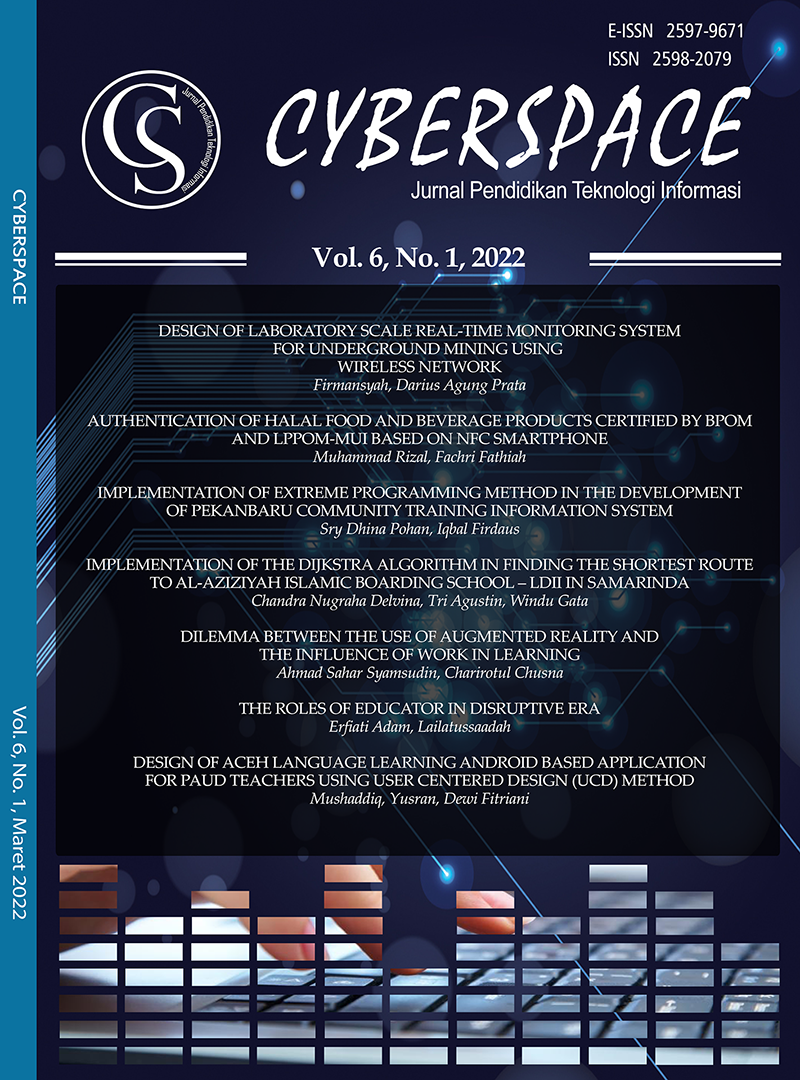DILEMMA BETWEEN THE USE OF AUGMENTED REALITY AND THE INFLUENCE OF WORK IN LEARNING
DOI:
https://doi.org/10.22373/cj.v6i1.11850Keywords:
Gawai, Augmented Reality, Pembelajaran, DilemaAbstract
Abstract
This article aims to analyze the problems that often arise in society regarding the use of Augmented Reality technology and gadgets. The problem is the feeling of dilemma when using gadgets as learning media to activate the Augmented Reality feature as a new innovation in learning. The method used is descriptive qualitative. The data is taken from the relevant literacy and then described and analyzed related to the contents of the use of Augmented Reality technology and the use of gadgets in learning. The results obtained are positive and negative impacts caused by the use of gadgets and the application of Augmented Reality in learning. Therefore, if humans can think broadly and futuristic and are aware of the changing times, it is hoped that humans can blend in and interact with technology. So that it can eliminate or minimize negative impacts and can benefit from positive impacts. For this reason, it is necessary to have an awareness, commitment, and certain regulations in the use of gadgets and Augmented Reality.
Keywords: Device, Augmented Reality, Learning, Dilemma.
Abstrak
Artikel ini bertujuan untuk menganalisis permasalahan yang kerap timbul di masyarakat terkait penggunaan teknologi Augmented Reality dan gawai. Permasalahan tersebut ialah perasaan dilema saat menggunakan gawai sebagai media pembelajaran untuk mengaktifkan fitur Augmented Reality sebagai inovasi baru dalam pebelajaran. Metode yang dipakai ialah kualitatif deskriptif. Data diambil dari literasi yang relevan kemudian di deskripsi dan dianalisis terkait isi tentang pemanfaatan teknologi Augmented Reality dan penggunaan gawai dalam pembelajaran. Hasil yang diperoleh ialah adanya dampak positif sekaligus negatif yang ditimbulkan dalam penggunaan gawai dan penerapan Augmented Reality dalam pembelajran. Oleh karena itu, bila manusia dapat berfikir secara luas dan futuristik serta menyadari terhadap perubahan jaman maka diharapkan manusia dapat berbaur dan berinteraksi dengan teknologi. Sehingga dapat menghilangkan atau meminimalisir dampak negatif dan dapat meraih manfaat dari dampak positif. Untuk itu perlu adanya suatu kesadaran, komitmen, dan peraturantertentu dalam pemanfaatan gawai dan Augmented Reality.
Kata Kunci: Gawai, Augmented Reality, Pembelajaran, Dilema.
References
Sugiyono, Metode Penelitian Kuantitatif, Kualitatif, dan R&D. 2013.
Diskominfo, “Survei penggunaan Teknologi informasi dan Komunikasi DKI Jakarta 2019,” p. 17, 2019.
Badan Pusat Statistik Indonesia, “STATISTIK TELEKOMUNIKASI INDONESIA 2019,” 2019.
E. Devega, “Aplikasi Live Streaming Kini Digandrungi Generasi Muda,” 2017, [Online]. Available: https://kominfo.go.id/content/detail/12071/aplikasi-live-streaming-kini-digandrungi-generasi-muda/0/sorotan_media.
Anonymus, “67 Persen Pengguna Handphone Berbelanja Lewat Smartphone,” 2015, [Online]. Available: https://kominfo.go.id/content/detail/5427/67-persen-pengguna-handphone-berbelanja-lewat-smartphone/0/sorotan_media.
I. Zulkarnain, H. Husaini, K. Baekhaki, and F. Y. Christian, “Relasi Antara Penggunaan Android dan Perubahan Sosial Perdesaan: Studi Perubahan Sosial di Kabupaten Bogor Jawa Barat,” Society, vol. 4, no. 2, pp. 1–14, 2016, doi: 10.33019/society.v4i2.25.
A. S. Cahyono, “Pengaruh Media Sosial Terhadap Perubahan Sosial Masyarakat di Indonesia,” J. Publiciana, vol. 9, no. 1, pp. 140–157, 2016.
C. Chaidirman, D. Indriastuti, and N. Narmi, “Fenomena Kecanduan Penggunaan Gawai (Gadget) pada Kalangan Remaja Suku Bajo,” Holist. Nurs. Heal. Sci., vol. 2, no. 2, pp. 33–41, 2019, doi: 10.14710/hnhs.2.2.2019.33-41.
D. A. M. Mindi Maria Domitila, Fajar Wulandari, “Analisis Penggunaan Gawai Terhadap Interaksi Sosial Anak Sekolah DasarNegeri Kota Singkawang,” vol. 6, no. 2, pp. 131–141, 2021.
N. Oktavia and M. Mulabbiyah, “Gawai Dan Kompetensi Sikap Sosial Siswa Mi (Studi Kasus Pada Siswa Kelas V Min 2 Kota Mataram),” El Midad, vol. 11, no. 1, pp. 19–40, 2019, doi: 10.20414/elmidad.v11i1.1903.
N. R. Radliya, S. Apriliya, and T. R. Zakiyyah, “Pengaruh Penggunaan Gawai Terhadap Perkembangan Sosial Emosional Anak Usia Dini,” J. Paud Agapedia, vol. 1, no. 1, pp. 1–12, 2017, doi: 10.17509/jpa.v1i1.7148.
A. A. Rahayu R, A. Amalia, S. N. Handayani, and Y. Rostikawati, “Dampak Penggunaan Gawai Terhadap Hasil Belajar Mahasiswa IKIP Siliwangi,” Parol. (Jurnal Pendidik. Bhs. dan Sastra Indones., vol. 1, no. 2, pp. 157–164, 2018, [Online]. Available: http://dx.doi.org/10.22460/p.v1i2p%25p.192.
Alan B. Craig, Augmented Reality. Concepts and Applications (2013), Steve Elli. Waltham: Elsevier, 2013.
M. Qori’Untiarasani, H. Haryanto, and E. Astuti, “Pembangunan Perangkat Lunak Interaktif Berbasis Markerless Augmented Reality Untuk Pengenalan Hewan Pada Taman Kanak,” Techno. Com, vol. 14, no. 2, pp. 159–164, 2015.
F. P. Juniawan, D. Y. Sylfania, H. A. Pradana, and L. Laurentinus, “Introduction of traditional Bangka musical instruments with marker-based augmented reality,” Regist. J. Ilm. Teknol. Sist. Inf., vol. 5, no. 2, pp. 77–93, 2019, doi: 10.26594/register.v5i2.1498.
P. S. Darmawel, “Usability Analysis on the Endangered Indonesian Animals and Plants Augmented Reality Application,” J. Techno Nusa Mandiri, vol. 17, no. 2, pp. 79–86, 2020, doi: 10.33480/techno.v17i2.1458.
D. S. Prayoga, I. N. Lodra, and A. Abdillah, “Menanamkan Pendidikan Karakter Melalui Media Augmented Reality Animasi Dua Dimensi Lakon Dewa Ruci kepada Remaja,” Rekam, vol. 16, no. 1, pp. 21–27, 2020, doi: 10.24821/rekam.v16i1.3482.
M. H. Al-Ghifari and M. Rizqi, “Game Portal Virtual Tugu Pahlawan Dengan Mobile Device Menggunakan Augmented Reality,” J. Animat. Games Stud., vol. 6, no. 2, pp. 113–128, 2020, doi: 10.24821/jags.v6i2.4212.
I. Mustaqim, “PEMANFAATAN AUGMENTED REALITY SEBAGAI MEDIA PEMBELAJARAN,” J. Pendidik. Teknol. dan Kejuru., vol. 13, no. 2, pp. 728–732, 2016, doi: 10.1109/SIBIRCON.2010.5555154.
Downloads
Published
Issue
Section
License
Authors who publish with Cyberspace Journal agree to the following terms:
- Authors retain copyright and grant the journal right of first publication with the work simultaneously licensed under a Creative Commons Attribution License that allows others to share the work with an acknowledgement of the work's authorship and initial publication in this journal.
- Authors are able to enter into separate, additional contractual arrangements for the non-exclusive distribution of the journal's published version of the work (e.g., post it to an institutional repository or publish it in a book), with an acknowledgement of its initial publication in this journal.
- Authors are permitted and encouraged to post their work online (e.g., in institutional repositories or on their website) prior to and during the submission process, as it can lead to productive exchanges, as well as earlier and greater citation of published work (See The Effect of Open Access).



















